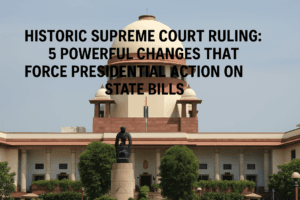Historic Supreme Court Ruling: 5 Powerful Changes That Force Presidential Action on State Bills
In a landmark verdict, India’s Supreme Court mandated a three-month deadline for the President to approve or reject bills forwarded by state governors, addressing systemic delays that often stalled opposition-led states’ legislation. The ruling, prompted by Tamil Nadu Governor R.N. Ravi’s refusal to clear 10 bills, clarified that presidential inaction under Article 201 is subject to judicial review, dismantling the “pocket veto” power.
The Court emphasized that constitutional validity disputes must be resolved by judges—not executives—via Article 143, reinforcing the judiciary’s role as a constitutional check. By requiring documented reasons for delays, the decision promotes transparency, curbs partisan gridlock, and safeguards state legislatures’ autonomy. This ruling strengthens India’s federal structure, ensuring governance isn’t held hostage to political brinkmanship while setting a precedent for accountable, time-bound executive action.

Historic Supreme Court Ruling: 5 Powerful Changes That Force Presidential Action on State Bills
In a groundbreaking judgment with far-reaching implications for India’s federal structure, the Supreme Court has established a three-month deadline for the President to decide on bills forwarded by state governors. The ruling, delivered on April 12, 2025, overturns Tamil Nadu Governor R.N. Ravi’s withholding of assent to 10 bills and clarifies constitutional boundaries for executive authority.
The Case That Sparked Change
The dispute arose when Tamil Nadu’s government challenged Governor Ravi’s refusal to clear bills passed by the state legislature—a recurring flashpoint in Indian politics where governors, appointed by the central government, have often been accused of stalling state agendas. The Supreme Court bench, comprising Justices J.B. Pardiwala and R. Mahadevan, condemned such delays as unconstitutional, asserting that “inaction is not an option” for constitutional authorities.
Key Takeaways from the Judgment
- Three-Month Presidential Deadline:
For the first time, the Court mandated that the President must grant or withhold assent to reserved bills within 90 days. Failure to act empowers states to seek judicial intervention, dismantling the notion of an unchecked “pocket veto.”
- Judicial Review of Executive Actions:
The verdict clarifies that the President’s duties under Article 201 (governing assent to state bills) are subject to judicial scrutiny. This curbs arbitrary executive power and reinforces the judiciary’s role as a constitutional check.
- Constitutional Validity: Courts, Not Executives, Decide:
The bench emphasized that questions about a bill’s legality must be resolved by the judiciary, not the executive. Governors or the President cannot withhold assent solely over constitutional doubts; such issues must be referred to the Supreme Court under Article 143 (advisory jurisdiction).
- Reasoned Decisions Required:
Any delay beyond the three-month window demands documented explanations communicated to the state, ensuring transparency.
Why This Ruling Matters
- Prevents Political Gridlock: Governors in states governed by opposition parties have frequently stalled bills, creating legislative paralysis. This ruling disrupts that pattern, ensuring smoother governance.
- Empowers State Legislatures: By setting deadlines, the Court safeguards states’ autonomy, a cornerstone of India’s federal system.
- Strengthens Accountability: The judgment underscores that constitutional offices must act within “reasonable time,” a principle now enforceable by law.
Broader Implications for Indian Democracy
Legal experts hail the decision as a corrective measure for India’s often-contentious state-center relations. “This ends the era of governors acting as partisan bottlenecks,” notes constitutional scholar Dr. Amit Singh. “It’s a win for cooperative federalism.”
The ruling also signals the judiciary’s proactive stance in resolving systemic ambiguities. By mandating timelines absent in the Constitution, the Court addresses a longstanding gap, ensuring that procedural delays don’t derail democratic processes.
The Road Ahead
While the verdict resolves immediate disputes in Tamil Nadu, its ripple effects will reshape governance nationwide. States like Kerala and Punjab, which have faced similar standoffs with governors, may now leverage this precedent to expedite pending legislation.
However, challenges remain. The ruling’s success hinges on adherence by the executive and timely judicial oversight. As Justice Mahadevan observed, “Constitutional morality must guide authority, not obstruction.”
In Summary
The Supreme Court’s intervention marks a pivotal shift toward accountable governance, ensuring that elected state legislatures can function unimpeded. By delineating clear boundaries for presidential and gubernatorial powers, the judgment fortifies India’s democratic framework—one where checks and balances prevail over political brinkmanship.
You must be logged in to post a comment.